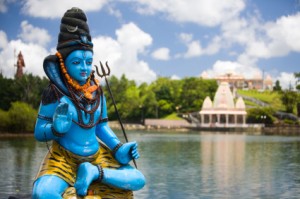
Hinduism is a religion of thousands of gods, or manifestations of gods. One of the most important is Shiva, the lord of destruction. The god represents the destruction of the world, after which it is born again. Also, in a more positive sense, he is concerned with the destruction of the ego, the attachment to worldly form, and the shedding of old habits – that is, purification.
The feast of Shiva is celebrated on the 13th night and the 14th day of the Hindu month of Maagha. The holy day is called Shivaratri, the Night of Shiva. By tradition, it was on this night that Shiva danced the Tandava Nritya, a dance of creation, preservation and destruction. Devotion to Shiva on the Shivaratri absolves the worshiper of sin.
One common form of Shivaratri devotion is to build a three-tiered platform around a fire. The three levels represent earth, space and heaven. Eleven urns represent the manifestations of Shiva as destroyer. Women are especially involved in these rituals.
Although Shiva is the god of destruction, he has creative energy, and this energy is represented by the lingam. The lingam is a phallus symbol, surrounded at its base by the yoni, the symbol of the female organ. Reverence toward the lingam is widespread in Hindu temples.
An abhishekam is the Hindu offering of libations. Libations poured or dripped over the lingam may be ghee (clarified butter), milk, sugar, honey or curd – the foods of immortality. Milk, urine and dung are also used in worship of the lingam. Along with ghee and curd, they are products of the cow, the sacred animal of Hinduism.
Some of the most ascetic yogis in Hinduism are Sivaite yogis. During the Night of Shiva they smear their bodies with white ashes, a symbol of purity, and dress in the beautiful color saffron.
Another tradition during the night of Shiva is to wear of a rudraksha mala. A mala is a set of prayer beads, a bead chain of 108 beads. The rudraksha is a certain broad-leaf tree that grows in India, and its seeds are used to make a rudraksha mala. The mala is a tool for meditation.
During the holyday, worshippers chant the sacred panchakshara (five-syllable) mantra: “Om Namah Shivaya”
The Night of Shiva is also a festival of cannabis. Pilgrims smoke charas, a form of hashish, derived from cannabis, or marijuana. Smoking charas produces a visionary state, a religious ecstasy.
Worship in temples is led by priests called pujaris. Pujaris traditionally come from the Brahmin class. In their minister training, they study Hindusim from childhood. They become experts at scripture and ritual before they get ordained. Some get ordained with great ceremony; others become spiritual leaders with no ceremony at all.
Ministers of the Universal Life Church are interfaith – they offer pastoral care to people of all religious traditions, and the foundation offers minister training in every faith. Anyone who respects an individual’s religion is welcome in The Universal Life Church, and ministry can be very rewarding.

